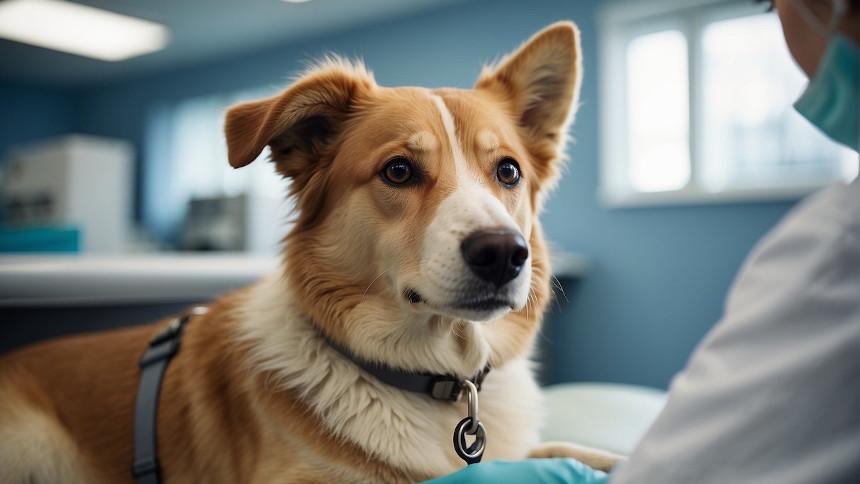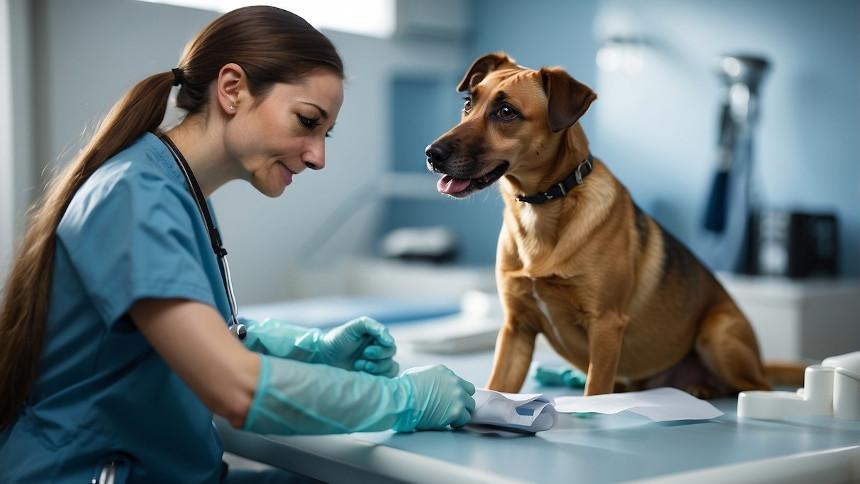When a dog yelps upon being picked up, it is often a sign that the pet is experiencing some form of discomfort or pain. This reaction can be due to a variety of reasons which may include physical ailments such as joint or muscle issues, recent vaccinations, or even anxiety. Identifying the cause is crucial in addressing the dog’s distress and ensuring proper care.
Injuries, particularly to the musculoskeletal system, are common culprits behind a dog’s yelping. These can range from subtle strains to more serious conditions like arthritis. Additionally, a dog may express discomfort if picked up improperly, putting unnecessary strain on its body.
Understanding a dog’s body language and the context in which they display signs of pain can help interpret their well-being. Seeking professional advice from a veterinarian is advised to diagnose any underlying health issues accurately. Observational skills and knowledge of proper handling techniques also play a vital role in preventing injury and ensuring the comfort and safety of the dog.
Understanding Canine Vocalizations
Canine vocalizations are a critical component of dog communication, with each sound serving a specific purpose. Dogs yelp, whine, howl, and use other forms of vocal expressions to convey their emotions and physical sensations.
Yelping is often an instinctive response to sudden pain or distress. If a dog cries out or yelps when picked up, it might indicate discomfort or fear. Reasons for this could include past trauma, such as being dropped or mishandled, or current physical pain from conditions such as arthritis or injury.
Whining can signify a range of feelings, from anxiety and fear to excitement and anticipation. It differs from yelping in that it is often a sustained sound, and it might occur when a dog is seeking attention or has unmet needs.
A dog’s howl, a prolonged, mournful cry, usually indicates loneliness or the need to alert others to their presence. It can also be a response to high-pitched sounds or sirens.
| Vocalization | Typical Causes | Description |
|---|---|---|
| Yelp | Pain or distress | A sharp, short sound, often due to hurt |
| Whine | Anxiety, anticipation | A continuous, high-pitched vocalization |
| Howl | Loneliness, communication | A prolonged, musical type of vocalization |
A knowledge of dog vocalizations is imperative to understand their emotions and needs. By recognizing the type of vocalization, an owner can better address any underlying issues. A dog yelping upon being lifted warrants a closer examination for potential injuries or psychological discomfort. In any case, consulting a veterinarian is advisable if the behavior persists or is of concern.
Common Causes of Pain in Dogs
When dogs experience pain, it is often a result of underlying health issues that can range from joint and muscle problems to gastrointestinal discomfort or injuries. Identifying the cause of pain is crucial for proper treatment and care.
Joint and Muscle Issues
Dogs can suffer from a variety of joint and muscle issues, such as arthritis and soft tissue injuries, which can lead to pain and discomfort. Arthritis is particularly common in older dogs and can cause joint pain, swelling, and chronic aches in the hips, knees, and other joints. Muscle problems can also be a source of acute or chronic pain, manifesting as limping or reluctance to move. Osteoarthritis is another degenerative condition that can lead to joint stiffness and significant discomfort in affected dogs.
Gastrointestinal and Abdominal Pain
Abdominal pain can arise from gastrointestinal issues and can be indicative of a more serious underlying condition. Symptoms may include visible discomfort, changes in posture, and vocalization when touched. Conditions that can cause such pain include gastritis, pancreatitis, or intestinal blockages. It’s important to note that abdominal pain might not always be immediately apparent, as dogs might display subtle changes in behavior or eating habits before showing obvious signs of discomfort.
Injuries and Accidents
Trauma from injuries or accidents can result in immediate and evident pain. Physical pain can be due to injuries such as bruises, fractures, or sprains. Dogs may cry out in pain, exhibit limping, or avoid putting weight on a limb if they experience an injury. Neck pain or back pain could indicate a slipped disc or other spinal issues, which can be serious and require immediate attention. Underlying conditions that lead to acute injuries may require a thorough veterinary examination for proper diagnosis and treatment.
Behavioral Reasons for Yelping
When a dog yelps upon being picked up, it may not always be due to physical discomfort. Behavioral reasons can also lead to such a response, particularly if the dog is experiencing fear or anxiety, or simply reacting to surprise and excitement in its environment.
Fear and Anxiety Responses
Fear and anxiety are potent emotional states that can cause a dog to yelp. Dogs that have had traumatic experiences may associate being lifted with past negative events, leading to a fear response when being picked up. Signs of fear and anxiety in dogs include:
- Cowering or shaking
- Trying to escape or avoid being held
- Yelping or whining
Separation anxiety can also manifest when a dog is lifted, particularly if they anticipate being distanced from their owner or their safe space. This anticipatory anxiety may trigger a vocal expression of distress.
Dogs’ Reactions to Surprise and Excitement
Just as humans might gasp or shout when startled, dogs may yelp when surprised or excited. Sudden lifting can catch a dog off guard, resulting in a spontaneous yelp. This doesn’t necessarily reflect pain but could be the dog’s immediate reaction to an unexpected situation.
Dogs that are prone to excitement may also vocalize when picked up as part of an exaggerated greeting or in anticipation of a positive activity, such as going for a walk. In contrast, a dog that is calm may not vocalize when handled, unless taken by surprise.
Recognizing the difference between a yelp of discomfort and one of behavioral origin is important for understanding and responding appropriately to a dog’s needs.
Medical Conditions That Cause Yelping
When a dog yelps upon being picked up, it may be indicative of underlying medical conditions. These conditions can range from infections affecting the skin or ears to joint disorders and neurological issues. Identifying the cause is crucial for providing appropriate care.
Skin and Ear Infections
Skin Infections: Dogs can develop painful skin infections, such as hot spots, dermatitis, or fungal infections. These ailments can cause discomfort and pain, leading a dog to yelp when touched or handled.
Ear Infections: Infections in the ears can be deeply uncomfortable for dogs. If a dog yelps when lifted up near the ears, it may be suffering from an otitis externa or an internal ear disorder.
Joint Disorders
Hip Dysplasia: A genetic condition more common in larger breeds, hip dysplasia occurs when the hip joints develop abnormally. It can cause significant pain and stiffness, resulting in yelping when a dog’s hips are manipulated during lifting.
Joint Injuries: Acute injuries or the chronic wear and tear of arthritis can make handling painful. Ligament tears, strains, and the general inflammation of arthritis can all be reasons for yelping.
Neurological Causes
Spinal Issues: Disc problems or spinal cord diseases can cause intense pain and can be aggravated by movement, including picking up the dog. Even a minor spinal compression can be painful.
Neurological Disorders: Conditions that affect a dog’s nervous system, such as a pinched nerve or a neurological illness, can result in sensitivity to touch and unexpected yelping.
Signs Your Dog Might Be Injured
When a dog yelps upon being picked up, it may signal an injury or discomfort. Recognizing the signs of an injured dog is crucial for providing timely care. Below are key indicators pet owners should be aware of:
- Limping or Favoring a Limb: After setting the dog down, observe if they favor a particular limb or show reluctance to walk.
- Shaking or Trembling: This can be a sign of pain or distress and might occur when the dog is stationary or during an attempt to move.
- Lethargy or Decreased Activity: A dog who is usually active but now appears lethargic or unwilling to engage in normal activities may be in pain.
- Panting or Rapid Breathing: While panting can be normal, excessive panting, especially when the dog is at rest, could indicate discomfort.
- Changes in Posture: Dogs may hunch over or adopt an abnormal posture to avoid pain when dealing with an injury.
| Behavior | Potential Indication |
|---|---|
| Limping | Joint or limb injury |
| Reluctance to Move | General pain or discomfort |
| Shaking | Anxiety, pain, or neurological issue |
| Lethargy | Overall disinterest in activity due to pain |
| Panting | Pain, especially if panting is excessive or abnormal |
These signs may not conclusively prove an injury but necessitate a closer examination. If any of these behaviors are observed after a dog yelps when lifted, they should be assessed by a veterinarian to determine the source of pain and receive appropriate treatment.
Approaching and Handling a Dog in Pain
When a dog is in pain, its owner must approach and handle it with patience and understanding to avoid further distress or injury. Ensuring safe lifting techniques, gentle handling, and a comprehension of the dog’s behavior are pivotal.
Safe Lifting Techniques
To lift a dog who is in pain, an owner should use both hands, placing one under the dog’s chest and the other supporting the hind legs. This method distributes the dog’s weight evenly and prevents strain on sensitive areas. Children must be taught the correct way to lift a pet to prevent accidental harm.
- Front: Support the chest and upper body with one hand.
- Back: Place the other hand under the hip or hind legs to support the lower body.
Gentle Handling and Comfort
When dealing with a dog that yelps due to pain, a gentle touch and calm demeanor are essential. Speaking softly and using slow movements can keep the dog relaxed. Owners should provide positive reinforcement to soothe the dog; treats or gentle petting can help reassure it.
- Voice: Keep it soft and comforting.
- Touch: Gentle strokes, avoiding areas of discomfort.
Understanding Dog Behavior
A dog may show that it’s in pain through signs like whimpering or withdrawing. Recognizing these cues is crucial for the owner to adjust handling accordingly. If a dog is acting anxious or scared, it may require a slower approach or a different handling strategy. It’s often beneficial to watch for changes in behavior that necessitate a visit to the vet for a professional assessment.
When to Consult a Veterinarian
When a dog yelps upon being picked up, it is crucial for the owner to determine whether this is a sign of a medical problem that needs a professional assessment. Consulting a veterinarian is a responsible step to take if a dog displays signs of distress or pain that are not immediately explainable or resolvable at home.
Seeking Professional Help
Owners should seek professional help from a veterinarian:
- If the yelping is consistent or seems to be getting worse over time.
- When they observe any additional signs of illness, such as lethargy, loss of appetite, or changes in behavior.
- If the dog has had a recent injury or a possible traumatic event that could have led to physical harm.
- In cases where the yelping is accompanied by symptoms indicating stomach issues such as vomiting, diarrhea, or refusal to eat.
Diagnosis of Underlying Conditions
The veterinarian will:
- Conduct a thorough physical examination to check for any signs of pain or discomfort.
- Possibly recommend diagnostic tests like X-rays or blood tests to identify the root cause of the dog’s distress.
- Determine if there is a need for immediate treatment to alleviate pain or if a more detailed investigation into chronic medical conditions is necessary.
- Provide advice on managing the dog’s condition, which could range from medication to changes in handling or lifestyle.
Preventing Dog Yelps During Lifting
When a dog yelps during lifting, it often indicates discomfort or pain. To prevent this distressing response, several measures can be taken to ensure the safety and tranquility of both small and large breed dogs.
Proper Handling Techniques:
- Support the Chest and Hindquarters: Always lift a dog by supporting both the chest and the hind legs, preventing undue strain on any specific area.
- Be Mindful of Size: For small dogs, use a cradling gesture, while with large breeds, keep their spine aligned and avoid bending.
Creating a Calm Environment:
- Positive Experiences: Use positive reinforcement to create a calm atmosphere. Offer treats and soothing praise to associate lifting with a positive experience.
- Gradual Desensitization: If anxiety is present, slowly acclimate the dog to being held, starting with gentle patting, then progressing to brief lifts.
Health Considerations:
- Regular Check-Ups: A vet should examine dogs that yelp when lifted to rule out injuries or conditions such as arthritis or cramping.
- Follow Treatment Plans: If an injury is diagnosed, adhere strictly to the vet’s recommended treatment plan.
When in Doubt, Professional Advice:
- Seek a veterinarian’s guidance if unsure about how to lift your dog or if the yelping persists. This may prevent exacerbating an undetected injury or condition.
Treatment and Care for Common Dog Pains
When a dog exhibits pain or discomfort, especially upon being picked up, it is crucial to provide immediate and appropriate care. Timely treatment can alleviate discomfort and prevent further complications.
Home Care Strategies
For minor injuries or mild discomfort, here are some strategies:
- Rest: Ensure they have a quiet, comfortable place to rest and recover.
- Soft Bedding: Invest in orthopedic beds to support their joints.
- Weight Management: Maintain a healthy diet to prevent obesity, thereby reducing stress on joints.
If a dog has chronic conditions like arthritis, consider:
- Joint Supplements: Glucosamine and chondroitin supplements can support joint health.
Veterinary Interventions
Prompt consultation with a veterinarian is essential if home care does not resolve the pain or if pain is severe. Here is what to expect:
- Physical Examination: The vet will assess the dog’s condition and may perform a physical exam to determine the cause of pain.
- Diagnostic Testing: X-rays or blood tests may be conducted to diagnose medical conditions, such as arthritis or other joint problems.
- Treatment Plans: Depending on the diagnosis, treatment may include:
- Medications: Pain relief or anti-inflammatory medications.
- Surgery: In cases of severe injuries or medical conditions.
- Rehabilitation: Physical therapy can help in recovery and pain management.
- Long-Term Management: For chronic issues like arthritis, a comprehensive plan including pain management, weight control, and moderate exercise may be recommended.
Access to proper care and closely following veterinary advice are essential to managing a dog’s pain and ensuring their well-being.








